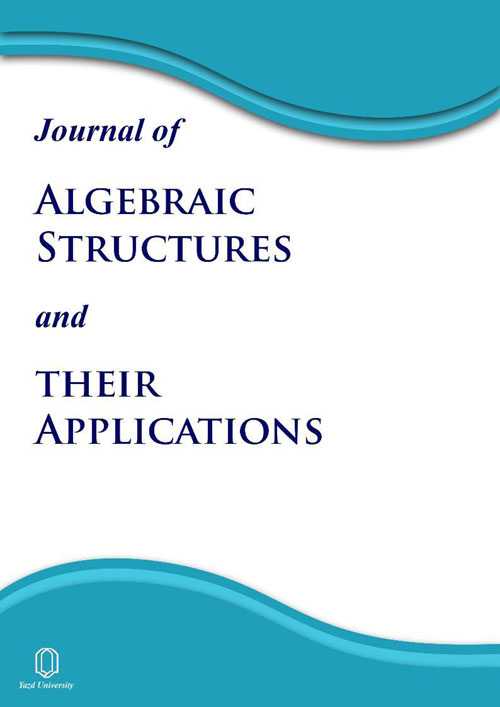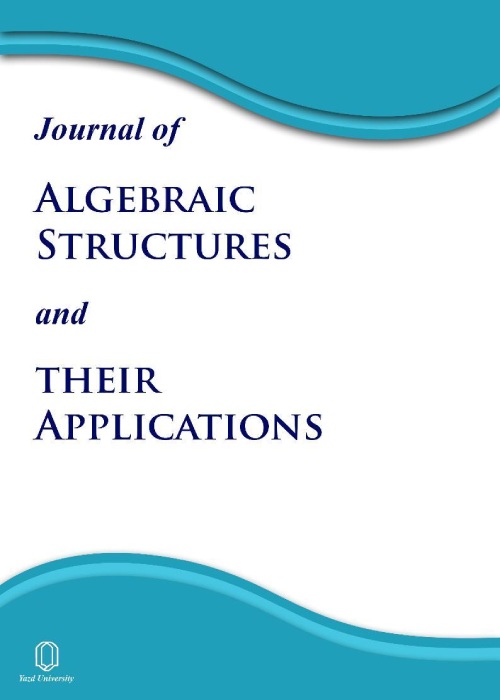فهرست مطالب

Journal of Algebraic Structures and Their Applications
Volume:7 Issue: 2, winter-spring 2020
- تاریخ انتشار: 1399/03/17
- تعداد عناوین: 12
-
-
Pages 1-13
Let $R$ be a commutative ring with identity and let $M$ be an $R$-module. In this paper, we will introduce the secondary radical of a submodule $N$ of $M$ as the sum of all secondary submodules of $M$ contained in $N$, denoted by $sec^*(N)$, and explore the related properties. We will show that this class of modules contains the family of second radicals properly and can be regarded as a dual of primary radicals of submodules of $M$.
Keywords: Secondary module, completely irreducible submodule, and secondary radical -
Pages 15-28Let $G$ be a monoid with identity $e$. In this paper, first we introduce the notions of $G$-graded hyperrings, graded hyperideals and graded hyperfields in the sense of Krasner hyperring $R$. Also, we define the notion of a greded $R$-hypermodules and some examples are presented. Then we investigate graded maximal, graded prime and graded primary hyperideals of a graded hyperring $R$. Finally, we study graded maximal, graded prime and graded primary subhypermodules of a graded $R$-hypermodule $M$ and some interesting results on these concepts are given.Keywords: Hyperring, Hypermodule, Graded hyperring, Graded hypermodule
-
Pages 29-49The purpose of this paper is the study of Cayley graph associated to a semihypergroup(or hypergroup). In this regards first we associate a Cayley graph to every semihypergroup and then we study theproperties of this graph, such as Hamiltonian cycles in this graph. Also, by some of examples we will illustrate the properties and behavior of these Cayley graphs, in particulars we show that the properties of a Cayley graph associated to a semihypergroup is completely different with respect to the Cayley graph associated to a semigroup(group). Also, we briefly discuss on category of Cayley graphs associated to semihypergroups and construct a functor from this category to the category of digraphs. Finally, we give an application the Cayley graph of a hypergroupoid to a social network.Keywords: Semihypergroup, Cayley graph, Fundamental relation, Category, Social network
-
Pages 51-62The distinguishing index of a simple graph $G$, denoted by $D'(G)$, is the least number of labels in an edge labeling of $G$ not preserved by any non-trivial automorphism. We prove that for a connected graph $G$ with maximum degree $Delta$, if the minimum degree is at least two, then $ D'(G)leq lceil sqrt{Delta }rceil +1$. We also present graphs $G$ for which $D'(G)leq lceil sqrt{Delta (G)}rceil$.Keywords: distinguishing index, edge-colourings, upper bound
-
Pages 63-77The notion of a neutrosophic quadruple BCI-commutative ideal in a neutrosophic quadruple BCI-algebra is introduced, and several properties are investigated. Relations between a neutrosophic quadruple ideal and a neutrosophic quadruple BCI-commutative ideal are discussed, and conditions for the neutrosophic quadruple ideal to be a neutrosophic quadruple BCI-commutative ideal are given. Conditions for the neutrosophic quadruple set to be a neutrosophic quadruple BCI-commutative ideal are provided, and the extension property of a neutrosophic quadruple BCI-commutative ideal is considered.Keywords: Neutrosophic quadruple BCK, BCI-number, neutrosophic quadruple BCK, BCI-algebra, neutrosophic quadruple (closed) ideal, neutrosophic quadruple BCI-commutative ideal
-
Pages 79-91
Let $ mathbb {Z}_{n} $ be the ring of integers modulo $ n $. The unitary Cayley graph of $ mathbb {Z}_{n} $ is defined as the graph $ G( mathbb {Z}_{n} ) $ with the vertex set $ mathbb {Z}_{n} $ and two distinct vertices $a,b$ are adjacent if and only if $a-bin Uleft( mathbb {Z}_{n}right)$, where $ Uleft( mathbb {Z}_{n}right) $ is the set of units of $ mathbb {Z}_{n} $. Let $Gamma ( mathbb {Z}_{n} ) $ be the complement of $ G( mathbb {Z}_{n} ) $. In this paper, we determine the independence number of $ Gamma ( mathbb {Z}_{n} ) $. Also it is proved that $ Gamma ( mathbb {Z}_{n} ) $ is well-covered. Among other things, we provide condition under which $ Gamma ( mathbb {Z}_{n} ) $ is vertex decomposable.the formula is not displayed correctly!
Keywords: Independence number, Complete graph, Well-covered, Clique number, Vertex decomposable -
Pages 93-113
Let $mathcal F_{mathcal P}( L)$ ($mathcal F_{mathcal P}^{*}( L)$) be the $f$-rings of all (bounded) frame maps from $mathcal P(mathbb R)$ to a frame $L$. $mathcal F_{{mathcal P}_{infty}}( L)$ is the family of all $fin mathcal F_{mathcal P}( L)$ such that ${uparrow}f(-frac 1n, frac 1n)$ is compact for any $ninmathbb N$ and the subring $mathcal F_{{mathcal P}_{K}}( L)$ is the family of all $fin mathcal F_{mathcal P}( L)$ such that ${{,mathrm{coz},}}(f)$ is compact. We introduce and study the concept of real ideals in $mathcal F_{mathcal P}( L)$ and $mathcal F_{mathcal P}^*( L)$. We show that every maximal ideal of $mathcal F_{mathcal P}^{*}( L)$ is real, and also we study the relation between the conditions ``$L$ is compact" and ``every maximal ideal of $mathcal F_{mathcal P}(L)$ is real''. We prove that for every nonzero real Riesz map $varphi colon mathcal F_{mathcal P}( L)rightarrow mathbb R$, there is an element $p$ in $Sigma L$ such that $varphi=widetilde {p_{{{,mathrm{coz},}}}}$ if $L$ is a zero-dimensional frame for which $B(L)$ is a sub-$sigma$-frame of $L$ and every maximal ideal of $mathcal F_{mathcal P}( L)$ is real. We show that $mathcal F_{{mathcal P}_{infty}}(L)$ is equal to the intersection of all free maximal ideals of $ mathcal F_{mathcal P}^{*}(L) $ if $B(L)$ is a sub-$sigma$-frame of a zero-dimensional frame $L$ and also, $mathcal F_{{mathcal P}_{K}}(L)$ is equal to the intersection of all free ideals $mathcal F_{mathcal P}( L)$ (resp., $mathcal F_{mathcal P}^*( L)$) if $L$ is a zero-dimensional frame. Also, we study free ideals and fixed ideals of $mathcal F_{{mathcal P}_{infty}}( L)$ and $mathcal F_{{mathcal P}_{K}}( L)$.the formula is not displayed correctly!
Keywords: Lattice-ordered ring, Zero-dimensional frame, $F, {mathcal P}$-realcompact, Real Riesz map, Free ideal, Real ideal -
Pages 115-134
A many identities group (MI-group, for short) is an algebraic structure which is generalized a monoid with cancellation laws and is endowed with an invertible anti-automorphism representing inversion. In other words, an MI-group is an algebraic structure generalizing the group concept, except most of the elements have no inverse element. The concept of a topological MI-group, as a preliminary study, in the paper '' Topological MI-group: Initial study'' was introduced by M. Hol\v capek and N. \v Skorupov' a, and we have given a more comprehensive study of this concept in our two recent papers. This article is a continuation of the effort to develop the theory of topological MI-groups and is focused on the study of separation axioms and the isomorphism theorems for topological MI-groups. Moreover, some conditions under which a MI-subgroup is closed will be investigated, and finally, the existence of nonnegative invariant measures on the locally compact MI-groups are introduced.
Keywords: MI-groups, Monoids, Pseudoidentity elements, Topological MI-groups, Full MI-subgroups -
Pages 135-145
Suppose that G is a finite non-abelian group. Define the graph Γ(G) with the non-central conjugacy classes of G as vertex set and two distinct vertices A and B are adjacent if and only if there are x∈A and y∈B such that xy=yx. The graph Γ(G) is called the commuting conjugacy class graph of G and introduced by Mohammadian et al. in [A. Mohammadian, A. Erfanian, M. Farrokhi D. G. and B. Wilkens, Triangle-free commuting conjugacy class graphs, {J. Group Theory} {19} (3) (2016) 1049--1061]. In this paper, the graph structure of the commuting conjugacy class graph of nilpotent groups of order n are obtained in which n is not divisible by p5, for every prime factor p of n.
Keywords: Commuting conjugacy class graph, nilpotent group, p−group -
Pages 147-161
In this paper, we introduced the concepts of normlet and normal ideal in a pseudo-complemented almost distributive lattice and studied its properties. We have characterized normal ideals and established equivalent conditions for every ideal to become a normal ideal. Also, derived equivalent conditions for the set of all prime normal ideals of a pseudo-complemented ADL to become a Hausdorff space.
Keywords: Almost Distributive Lattice (ADL), Pseudo-complemented ADL, Normal ideal, Hausdorff space -
Pages 163-177
In this paper, we generalize the vector space by considering the group as a canonical m-ary hypergroup, the field as a Krasner (m,n)-hyperfield. Moreover, we define the m-ary hyper Banach spaces and investigate some of their related properties.
Keywords: m-ary hypervector space, Krasner $(m, n)$-hyperfield, Hypernorm, m-ary hyper Banach space -
Pages 179-193
Let Φ be a system of ideals of a commutative Noetherian ring, we study the annihilators and attached primes of local cohomology modules with respect to a system of ideals. We prove that if M is a non-zero finitely generated R-module of finite dimension d and Φ is a system of ideals, then Att(HdΦ(M))={p∈AssM∣cd(Φ,R/p)=d}. Moreover, if the cohomology dimension of M with respect to Φ is dimM−1, then Att(HdimM−1Φ(M))={p∈SuppM∣cd(Φ,R/p)=dimM−1}.
Keywords: Annihilators, Attached primes, Cohomological dimension, Local cohomology


